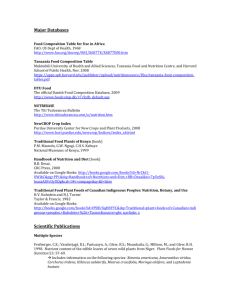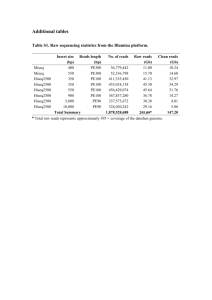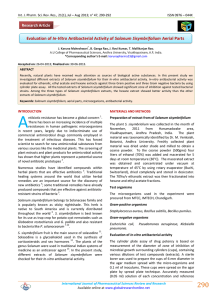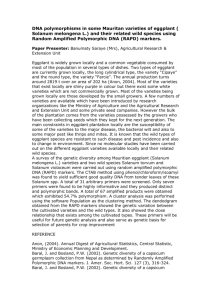Advance Journal of Food Science and Technology 3(1): 40-44, 2011
advertisement
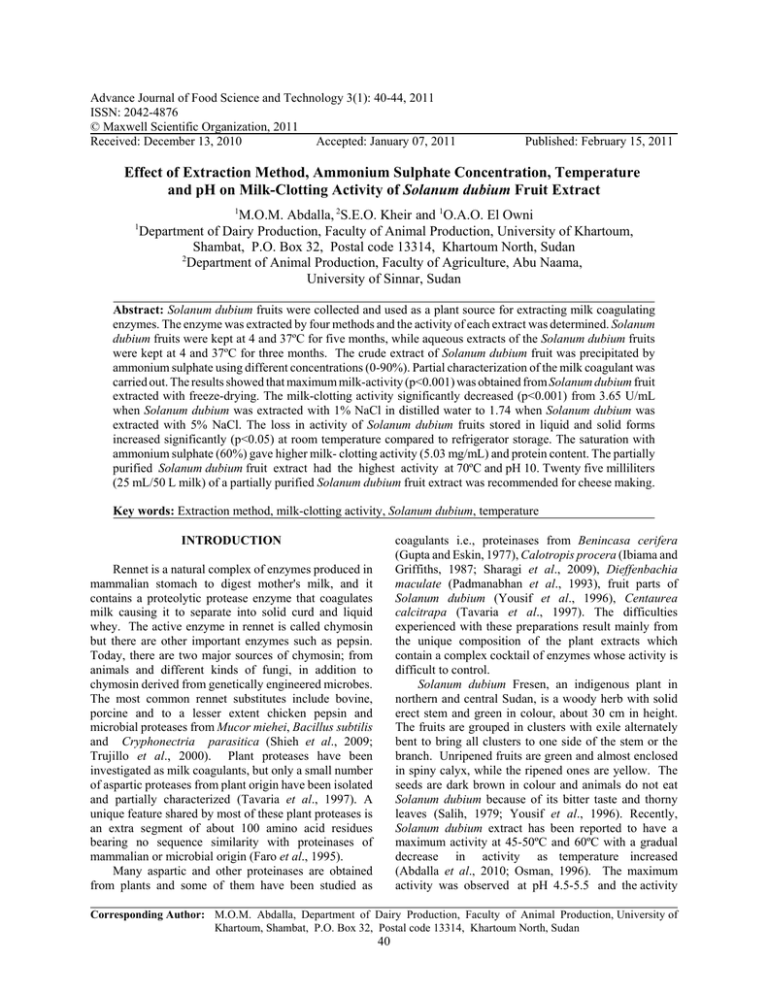
Advance Journal of Food Science and Technology 3(1): 40-44, 2011 ISSN: 2042-4876 © Maxwell Scientific Organization, 2011 Received: December 13, 2010 Accepted: January 07, 2011 Published: February 15, 2011 Effect of Extraction Method, Ammonium Sulphate Concentration, Temperature and pH on Milk-Clotting Activity of Solanum dubium Fruit Extract 1 1 M.O.M. Abdalla, 2S.E.O. Kheir and 1O.A.O. El Owni Department of Dairy Production, Faculty of Animal Production, University of Khartoum, Shambat, P.O. Box 32, Postal code 13314, Khartoum North, Sudan 2 Department of Animal Production, Faculty of Agriculture, Abu Naama, University of Sinnar, Sudan Abstract: Solanum dubium fruits were collected and used as a plant source for extracting milk coagulating enzymes. The enzyme was extracted by four methods and the activity of each extract was determined. Solanum dubium fruits were kept at 4 and 37ºC for five months, while aqueous extracts of the Solanum dubium fruits were kept at 4 and 37ºC for three months. The crude extract of Solanum dubium fruit was precipitated by ammonium sulphate using different concentrations (0-90%). Partial characterization of the milk coagulant was carried out. The results showed that maximum milk-activity (p<0.001) was obtained from Solanum dubium fruit extracted with freeze-drying. The milk-clotting activity significantly decreased (p<0.001) from 3.65 U/mL when Solanum dubium was extracted with 1% NaCl in distilled water to 1.74 when Solanum dubium was extracted with 5% NaCl. The loss in activity of Solanum dubium fruits stored in liquid and solid forms increased significantly (p<0.05) at room temperature compared to refrigerator storage. The saturation with ammonium sulphate (60%) gave higher milk- clotting activity (5.03 mg/mL) and protein content. The partially purified Solanum dubium fruit extract had the highest activity at 70ºC and pH 10. Twenty five milliliters (25 mL/50 L milk) of a partially purified Solanum dubium fruit extract was recommended for cheese making. Key words: Extraction method, milk-clotting activity, Solanum dubium, temperature coagulants i.e., proteinases from Benincasa cerifera (Gupta and Eskin, 1977), Calotropis procera (Ibiama and Griffiths, 1987; Sharagi et al., 2009), Dieffenbachia maculate (Padmanabhan et al., 1993), fruit parts of Solanum dubium (Yousif et al., 1996), Centaurea calcitrapa (Tavaria et al., 1997). The difficulties experienced with these preparations result mainly from the unique composition of the plant extracts which contain a complex cocktail of enzymes whose activity is difficult to control. Solanum dubium Fresen, an indigenous plant in northern and central Sudan, is a woody herb with solid erect stem and green in colour, about 30 cm in height. The fruits are grouped in clusters with exile alternately bent to bring all clusters to one side of the stem or the branch. Unripened fruits are green and almost enclosed in spiny calyx, while the ripened ones are yellow. The seeds are dark brown in colour and animals do not eat Solanum dubium because of its bitter taste and thorny leaves (Salih, 1979; Yousif et al., 1996). Recently, Solanum dubium extract has been reported to have a maximum activity at 45-50ºC and 60ºC with a gradual decrease in activity as temperature increased (Abdalla et al., 2010; Osman, 1996). The maximum activity was observed at pH 4.5-5.5 and the activity INTRODUCTION Rennet is a natural complex of enzymes produced in mammalian stomach to digest mother's milk, and it contains a proteolytic protease enzyme that coagulates milk causing it to separate into solid curd and liquid whey. The active enzyme in rennet is called chymosin but there are other important enzymes such as pepsin. Today, there are two major sources of chymosin; from animals and different kinds of fungi, in addition to chymosin derived from genetically engineered microbes. The most common rennet substitutes include bovine, porcine and to a lesser extent chicken pepsin and microbial proteases from Mucor miehei, Bacillus subtilis and Cryphonectria parasitica (Shieh et al., 2009; Trujillo et al., 2000). Plant proteases have been investigated as milk coagulants, but only a small number of aspartic proteases from plant origin have been isolated and partially characterized (Tavaria et al., 1997). A unique feature shared by most of these plant proteases is an extra segment of about 100 amino acid residues bearing no sequence similarity with proteinases of mammalian or microbial origin (Faro et al., 1995). Many aspartic and other proteinases are obtained from plants and some of them have been studied as Corresponding Author: M.O.M. Abdalla, Department of Dairy Production, Faculty of Animal Production, University of Khartoum, Shambat, P.O. Box 32, Postal code 13314, Khartoum North, Sudan 40 Adv. J. Food Sci. Technol., 3(1): 40-44, 2011 decreased with increasing pH value (Abdalla et al., 2010; Mohamed and Habbani, 1996). The objective of this investigation is to extract the enzyme with different methods and characterize it for milk-clotting activity in order to use it in cheese making as an alternative to rennet. Concentration of Solanum dubium extract by ammonium sulphate: The crude extract of Solanum dubium fruit was precipitated by ammonium sulphate using different concentrations (0-90%). Precipitation was carried out at 5ºC, and the precipitate was recovered by centrifugation. The supernatant was discarded and the sediment from each concentration was re-suspended in buffer solution (pH 10) and dialyzed against distilled water for 24 h, changing the distilled water six times. The enzyme was then dialyzed against buffer (pH 10) for 12 h. The volumes of the dialyzed enzyme concentration and protein contents were measured (Lowry et al., 1951). MATERIALS AND METHODS This study was conducted at the Department of Dairy Production, Faculty of Animal Production, University of Khartoum and Department of Animal Production, Faculty of Agriculture, University of Sinnar during the period April-December, 2008. Characterization of partially purified enzyme: Effect of incubation temperature on enzyme activity: The effect of incubation temperature on the enzyme activity was determined at 40, 50, 60, 70, 80, 90 and 100ºC. Casein solution (2%) in buffer at pH 10 was used as enzyme substrate. The enzyme concentrate was diluted to 100 fold, and 1 ml of the diluted enzyme solution was added to 1 mL of casein solution and incubated at the required temperature for 10 minutes. Proteolysis was stopped by the addition of 2 mL of 5% TCA (Anson, 1938). Enzyme extraction: Four extraction methods were tried to select the one with a reasonably high activity. Extraction with distilled water: Yellow fruits of Solanum dubium plant were powdered using laboratory mortar, then five grams were soaked in a conical flask for 24 h at 5ºC using distilled water (30 mL) with frequent shaking for the first 3 h and solutions were then filtered through filter paper. The aqueous filtrate was used for testing milk clotting activity. Effect of pH on enzyme activity: Casein solution (2% w/v) was suspended in a buffer of different pH values (4, 5, 6, 7, 8, 9, 10, 11, 12). Both enzymes and substrate were allowed to equilibrate with the incubation temperature of 37ºC before adding the enzyme to the substrate. Enzyme activity was measured according to Anson (1938). Drying in a current of warm air: The filtrate of Solanum dubium extract was spread on a shallow glass basin and exposed to a current of air at 45ºC till completely dry (Osman, 2001). Soaking in sodium chloride and evaporation in a current of warm air: Hundred grams of coarsely ground plant powder were soaked in 1, 2, 3, 4 and 5% sodium chloride for 24 h at 5ºC. The solution was filtered and the filtrate was finally spread on a shallow glass basin and exposed to a current of warm air at 45ºC (Osman, 2001). RESULTS AND DISCUSSION Extraction of the milk-clotting coagulant: The results show that, maximum milk-clotting activity (p<0.001) was obtained from Solanum dubium fruit extracted with freeze-drying (3.60±0.43U/mL), followed by Solanum dubium fruit extracted with distilled water and evaporated at 45ºC (3.39±0.74 U/mL) and Solanum dubium extracted by distilled water (1.30±0.17 U/mL). The lowest activity (0.05 U/mL) was obtained by extraction with 5% NaCl, and this extract was subjected to a current of warm air (45ºC). The results show that milk-clotting activity significantly decreased (p<0.001) from 3.65 U/mL when Solanum dubium was extracted with 1% NaCl in distilled water to 1.74 when Solanum dubium was extracted with 5% NaCl. Our results disagree with Yousif et al. (1996) who found that 5% NaCl solution extracted more of the compound associated with clotting in Solanum dubium. Abdalla et al. (2010) reported that the higher activity was obtained by Solanum dubium fruit extracted with distilled water, followed by Solanum dubium fruit extracted with freeze-drying, then Solanum dubium fruit extracted with Freeze-drying: The powdered yellow fruits (100 g) were soaked in a conical flask for 24 h using distilled water with occasional shaking for the first 3 h and the solution was kept at -25ºC and freeze-dried. Stability of Solanum extract: Powdered extract of Solanum dubium fruits (dried in a current of warm air) was kept at 4ºC and 37ºC for 5 months, while aqueous extract of the Solanum dubium fruits was kept at 4ºC and 37ºC for 3 months, and samples from each were tested every month for activity. Determination of crude Solanum extract activity: The activity of Solanum dubium fruit extract was determined according to the method described by Mohamed and Habbani (1996). 41 Adv. J. Food Sci. Technol., 3(1): 40-44, 2011 Table 1: Effect of storage temperature on activity (U/ml) of Solanum dubium extract (liquid and solid forms) Mean±S.D. ---------------------------------------------------------------------------------------------------------------------------------------------------Liquid form Solid form -------------------------------------------------------------------------------------------------------------------------------Storage (days) 4 (ºC) 37 (ºC) 4 (ºC) 37 (ºC) 1 1.85a±0.59 1.24a±0.25 4.51a±1.13 3.32a±0.65 0.58b±0.11 2.84b±0.32 2.76b±0.42 30 1.33b±0.12 60 1.08c±0.26 0.33c±0.07 2.06c±0.16 1.97c±0.15 0.07d±0.04 1.69d±0.14 1.62d±0.24 90 0.20d±0.05 120 1.60d±0.12 1.53d±0.17 150 1.21e±0.28 1.18e±0.19 L.S *** *** Means in each column bearing similar superscripts are not significantly different (p>0.05); LS: Level of significance for interaction; ***: (p<0.001) SD: Standard deviation Table 2: Effect of ammonium sulphate saturation (%) on milk clotting activity yield and fold of purification in Solanum dubium fruits Saturation of Protein content Specific ammonium Enzyme activity (mg/mL) activitya Total Yield c Fold of (%) purification d sulphate (%) Volume (mL) (U/mL) (units/mL) (units) activityb Crude enzyme 25 3100 85.5 36.26 77500 100 10 5.8 0.08 1.85 45.04 483.31 0.62 1.24 20 7.2 1.50 2.75 545.45 10800 13.94 15.04 30 8.8 3.283 6.25 525.33 28893 73.28 14.49 40 8.2 3.850 9.75 394.87 31570 40.74 10.89 50 8.6 4.33 10.00 433.33 37266 48.09 11.95 60 9.4 5.03 14.25 353.21 47313 61.50 9.74 70 9.8 4.33 13.50 320.99 42466 54.79 8.85 80 8.8 4.08 7.25 563.21 35933 46.37 15.53 90 10.3 3.83 9.50 403.51 39483 50.95 11.13 a : Specific activity = activity /protein content; b: Total activity = activity × volume of fraction; c: Yield = total activity of the fraction/total activity of crud enzyme × 100; d: Fold of purification = Specific activity of fraction/specific activity of the crude fraction Effect of ammonium sulphate concentration on activity of Solanum dubium extract: The crude extract of Solanum dubium fruits was precipitated with ammonium sulphate concentrations ranging from 0 to 90%. The results in Table 2 revealed that the saturation of 60% gave a higher milk-clotting activity (5.03 U/mL) as well as protein content (14.25 mg/mL) with 61.05% yield and 9.74 fold of purification. However, Abdalla et al. (2010) found that the saturation range of 40-50% gave the highest milk clotting activity as well as protein content, yield (27.5%) and fold of purification (1.88). distilled water and evaporated at 50ºC, while the lower activity was obtained by Solanum dubium fruit extracted with 5% NaCl in distilled water. Thermal stability of Solanum dubium extract: The effect of storage on activity of Solanum dubium extract in liquid and solid forms is presented in Table 1. Activity of Solanum dubium extract (liquid) stored at 37ºC decreased from 1.24±0.25 at day 1 to 0.07±0.04U/mL at day 90, but when stored at 4ºC the activity decreased from 1.85±0.59 at day 1 to 0.20±0.05 U/mL at day 90. In case of the solid form, the activity decreased from 3.32±0.65 at day 1 to 1.18±0.19 U/mL at day 150 when the extract was stored at 37ºC and from 4.51±1.13 U/mL at day 1 to 1. 21±0.28 U/mL at day 150 when stored at 4ºC (p<0.001). It is clear that the loss in activity on storage of solid Solanum dubium extract was much less as compared to liquid form. Further, the loss in activity of Solanum dubium extract in the liquid as well as solid forms was significantly more at 37ºC. In case of storage at 4ºC, the loss in activity was appreciably less. Hence, the storage of solid Solanum dubium extract at 4ºC was favorable for retaining the activity. Similar results were found by Singh et al. (1973) who studied vegetable rennet from Withania coagulans and found that the loss in activity on storage of solid rennet was much less at both refrigerator and room temperatures. Tejada et al. (2008) pointed that refrigerator storage of extract form of Cynara cardunculus L. can not be considered a suitable method for prolonged preservation of aqueous cardoon extract. Characterization of partially purified enzymes: Effect of incubation temperature on milk-clotting activity: It is obvious from Fig. 1 that Solanum dubium extract exhibited optimum temperature for milk clotting activity at 70ºC. The results are similar to Sidrach et al. (2005) who studied the milk clotting activity of Cynara scolymus and Ahmed et al. (2009a) who found that the enzyme from Solanum dubium Fresen seeds is thermostable retaining complete activity at 60ºC after 1 h and acts optimally at 70ºC for 30 min. However, the results of this investigation are in disagreement with Kumar et al. (2005), Aworh and Nakai (2006), Pascaline and Daniel (2006), Raposo and Domingos (2008) and Nouani et al. (2009). Effect of pH on the activity of Solanum dubium extract: The activity of Solanum dubium extract on a pH 42 Adv. J. Food Sci. Technol., 3(1): 40-44, 2011 activity, protein content and yield. Milk-clotting ctivity increased with increasing incubation temperature and reached its maximum activity at 70ºC, while the activity reached its maximum at pH 9. 16 Milk clotting activity (mg tyrosine/ml) 14 12 10 8 ACKNOWLEDGEMENT 6 The authors would like to acknowledge the help of the staff of the Department of Dairy Production, Faculty of Animal Production and the Department of Animal Production, Faculty of Agriculture, University of Sinnar. 4 2 0 40 50 60 80 70 Temperature °C 100 90 REFERENCES Fig. 1: Effect of incubation temperature on milk clotting activity of partially purified Solanum dubium extract Abdalla, M.O.M., A.A.D. Ali and E.B. Mohamed, 2010. Extraction, milk-clotting activity measurements and purification of Solanum dubium Fresen (Gubbain) for cheesemaking. World J. Dairy Food Sci., 5(2): 152-159. Ahmed, I.A.M., I. Morishima, E.E. Babiker and N. Mori, 2009a. Characterization of partially purified milkclotting enzyme from Solanum dubium Fresen seeds. Food Chem., 116(2): 395-400. Ahmed, I.A.M., I. Morishima, E.E. Babiker and N. Mori, 2009b. Dubiumin, a chymotrypsin-like serine protease from the seeds of Solanum dubium Fresen. J. Phytochem., 70(4): 483-491. Anson, M.L., 1938. The estimation of pepsin, trypsin, papin and cathepsin with hemoglobin. J. Gen. Physiol., 22: 79-89. Aworh, C.O. and S. Nakai, 2006. Extraction of milk clotting enzyme from Sodom Apple (Calotropis procera). J. Food Sci., 51(6): 1569-1570. El-Bendary, A.M., E.M. Moharam and H.T. Ali, 2007. Purification and characterization of milk clotting enzyme produced by Bacillus sphaericus. J. Appl. Sci. Res., 3(8): 695-699. Faro, C.J., P. Verissimo, Y. Lin, J. Tang and E.V. Pires, 1995. Aspartic Proteinases: Structure, Function, Biology and Biomedical Implications. Takahashi, K. (Ed.), Plenum Press, New York, USA, pp: 373-377. Gupta, S.K. and N.A.M. Eskin, 1977. Potential use of vegetable rennet in the production of cheese. Food Technol., 31: 62-64. Ibiama, E. and M.W. Griffiths, 1987. Studies on a milkcoagulating enzyme, calotropain, obtained from Sodom apple (Calotropis procera). J. Sci. Food Agric., 1: 157-162. Ishak, R., M.A.I. Yousif, M. Shuhaimi, S. Abdulah, S.M. Kharidah and Y.A. Mohd, 2006. Factors affecting milk coagulating activities of Kesinai (Streblus asper) extract. Int. J. Dairy Sci., 1(2): 131-135. Kumar, S., S.S. Neeru, R.S. Mukh and S. Randhir, 2005. Extracellular acid protease from Rizopus oryzae. Purification and characterization. Process Chem., 40(5): 1701-1705. 8 Milk clotting activity (mg tyrosine/ml) 7 6 5 4 3 2 1 0 4 5 6 7 9 8 10 11 12 pH Fig. 2: Effect of pH on milk-clotting activity of partially purified Solanum dubium extract range from 4 to 12 is shown in Fig. 2. Results show that the activity of Solanum dubium extract increased with increasing pH value from 4 up to 10 which was the maximum activity, and then the activity declined. The findings disagree with Osman (2001) who reported the maximum activity of Solanum extract to be at pH 5.5 and the enzyme activity decreased with increasing pH value, and Kumer et al. (2005), Aworh and Nakai (2006), Ishak et al. (2006), El-Bendary et al. (2007), Raposo and Domingos (2008) and Nouani et al. (2009). Ahmed et al. (2009b) reported that chymotrypsin-like serine protease from the seeds of Solanum dubium Fresen acted optimally at pH 11, and was stable over a wide range of pH 3.0-12.0. The milk clotting activity of a partially purified extract enzyme from glutinous rice wine mash liquor increased with decreasing milk pH from 8.0 to 5.5, and it was active at the wide range of pH 1-7 (Wang et al., 2009). CONCLUSION From this study it could be concluded that the storage temperature significantly affected the activity of Solanum dubium extract (liquid and solid forms), and that 60% ammonium ulphate saturation gave the best milk-clotting 43 Adv. J. Food Sci. Technol., 3(1): 40-44, 2011 Sharagi, H.S., G.S. Aboud and A.K. Shaker, 2009. Use of protease from Calotropis procera for accelerated ripening of Monterey cheese. Jordanian J. Agric. Sci., 5(4): 556-577. Shieh, C., P.L. Thi and I. Shih, 2009. Milk-clotting enzymes produced by culture of Bacillus subtilis natto. Biochem. Eng. J., 43: 85-91. Sidrach, S.L., F. Garcia-Canovas, J. Tudela and N.J. Rodriguez-Lopez, 2005. Purification of cynarases from artichoke (Cynara scolymus L.): Enzymatic properties of cynarase A. Phytochemistry, 66(1): 41-49. Singh, J., C. Harish, V.R. Bhalerao and N. Noshir, 1973. Studies on vegetable rennet from Withania coagulans. J. Food Sci. Technol., India, 10: 16-19. Tavaria, F.K., M.J. Sousa, A. Domingos, F.X. Malcata, A. Brodelius, A. Clemente and M.S. Pais, 1997. Degradation of caseins from different milk types by extracts of Centaurea calcitrapa. J. Food Chem., 45: 3760-3765. Tejada, L., A. Abellan, F. Prados and J.M. Cayuela, 2008. Composition characteristics of Murica al Vino goat's cheese made with calf rennet and plant coagulant. Int. J. Dairy Technol., 61(2): 119-125. Trujillo, J.A., B. Huamis, J. Laencina and B.M. Lopez, 2000. Proteolytic activities of some milk clotting enzymes on ovine casein. Food Chem., 71: 449-457. Wang, Y., O. Cheng, Z. Ahmed, X. Jiang and X. Bai, 2009. Purification and partial characterization of milk-clotting enzyme extracted from glutinous rice wine mash liquor. Korean J. Chem. Eng., 26(5): 1313-1318. Yousif, B.H., D.J. McMahon and K.M. Shammet, 1996. Milk clotting enzyme from Solanum dubium plant. Int. Dairy J., 6: 637-644. Lowry, O.H., N.J., Rosenbrough, A.L. Farr and R.L. Randall, 1951. Protein measurement with Folin Phenol Reagent. J. Biol. Chem., 193: 265-275. Mohamed, B.E. and E.S. Habbani, 1996. Utilization of Solanum dubium fresen for cheese making. J. Agric. Sci., 4(2): 139-148. Nouani, A., E. Dako, A. Morsli, N. Belhamiche, S. Belbraouet, M.M. Bellal and A. Dadie 2009. Characterization of the purified coagulant extracts derived from Artichoke flowers (Cynara scolymus) and from the fig tree latex (Ficus carica) in light of their use in the manufacture of traditional cheeses in Algeria. J. Food Technol., 7(1): 20-29. Osman, A.A.D., 2001. Studied on a rennet substitute from Solanum dubium Fresen (Gubbain). Ph.D. Thesis, University of Khartoum, Sudan. Osman, M.S., 1996. Purification and characterization of milk clotting protease from Solanum dubium. M.Sc. Thesis, University of Khartoum, Sudan. Padmanabhan, S., A. Chitre and N.V. Shastri, 1993. Milk clotting protease isolated from Diffenbachia maculate. Nahrung, 37: 99-101. Pascaline, G. and M. Daniel, 2006. Heat-stability of milkclotting enzyme in conditions Encountered in Swiss cheese making. J. Food Sci., 52(1): 75-77. Raposo, S. and A. Domingos, 2008. Purification and characterization milk-clotting aspartic protinases from Centaurea cell suspention cultures. Process Biochem., 43: 139-144. Salih, H.M., 1979. Investigation of alkaloidal content of certain Solanum species. M.Sc. Thesis, University of Khartoum, Sudan. 44
